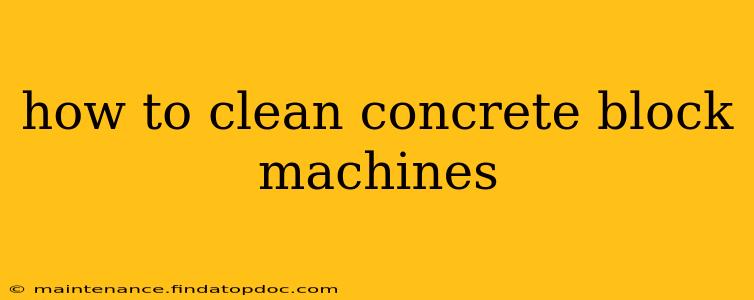Concrete block machines are vital pieces of equipment for construction and manufacturing. Keeping them clean is crucial for optimal performance, preventing malfunctions, and ensuring the longevity of your investment. This comprehensive guide will walk you through the process of effectively cleaning your concrete block machine, addressing common questions and concerns.
Why Clean Your Concrete Block Machine Regularly?
Regular cleaning prevents several issues:
- Improved Product Quality: Residue buildup can lead to inconsistent block formation, surface imperfections, and compromised structural integrity.
- Extended Machine Lifespan: Caked-on concrete and other materials can cause wear and tear on moving parts, leading to premature failure and costly repairs.
- Efficient Operation: A clean machine operates smoothly, reducing downtime and increasing productivity.
- Safety: A clean machine is a safer machine. Build-up can create hazards, especially in moving parts.
What You'll Need for Cleaning
Before you begin, gather the necessary tools and supplies:
- Water: Plenty of water is essential for rinsing away concrete residue. A high-pressure washer can significantly expedite the process.
- Brushes: Stiff-bristled brushes are ideal for scrubbing away stubborn concrete. Consider different sizes for accessing various areas.
- Scrapers: Scrapers are useful for removing hardened concrete from hard-to-reach areas.
- Detergents: A mild detergent can help loosen and remove stubborn residue. Avoid harsh chemicals that could damage machine components.
- Safety Gear: Always wear safety glasses, gloves, and appropriate clothing to protect yourself from injury and chemical exposure.
- High-Pressure Washer (Optional but Recommended): A high-pressure washer significantly speeds up the cleaning process.
Step-by-Step Cleaning Process
1. Safety First: Always disconnect the power supply to the machine before beginning any cleaning process.
2. Initial Removal: Use scrapers and brushes to remove as much loose concrete and debris as possible. Focus on areas where concrete tends to accumulate, such as molds, hopper, and vibrating tables.
3. Washing: Thoroughly wash all accessible surfaces with water. A high-pressure washer is highly recommended for this step, allowing for efficient removal of hardened concrete. If using a detergent, follow the manufacturer's instructions carefully.
4. Stubborn Residue: For stubborn concrete residue, apply a mild detergent solution and let it sit for a few minutes before scrubbing with a brush. Repeat as needed.
5. Rinsing: After scrubbing, thoroughly rinse all surfaces with clean water to remove all traces of detergent and concrete residue.
6. Drying: Allow the machine to air dry completely before reassembling and operating.
What Type of Detergent Should I Use?
A mild detergent is generally recommended for cleaning concrete block machines. Avoid harsh chemicals that could damage the machine's components or create safety hazards. Always test any detergent in an inconspicuous area before applying it to the entire machine. Consult the manufacturer's recommendations for cleaning solutions suitable for your specific machine model.
How Often Should I Clean My Concrete Block Machine?
The frequency of cleaning depends on the usage and the type of concrete being used. However, a thorough cleaning after every batch or at least at the end of each workday is recommended to prevent buildup and ensure optimal performance. More frequent cleaning may be necessary if dealing with particularly sticky or abrasive concrete mixes.
What if I Have Specific Problems with My Concrete Block Machine?
If you encounter specific problems, like jammed molds or malfunctioning components, consult your machine's manual for troubleshooting guidance or contact the manufacturer directly. Don't attempt repairs unless you are qualified to do so.
Conclusion
Regular cleaning of your concrete block machine is essential for maintaining its efficiency, prolonging its lifespan, and ensuring the quality of your concrete blocks. By following these steps and using the appropriate cleaning supplies, you can keep your machine in top condition and minimize downtime. Remember, safety always comes first, so ensure the power is off before beginning any cleaning process.
